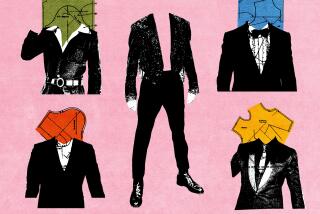Fashionable to a T
- Share via
Like no other article of clothing, the T-shirt has become a universal communicator of cool. A new book sets out to document the history of the blank cloth slate, which over the years has been embellished with political slogans, fashion logos, images of pop idols and tourist locales. Although it’s written by French fashion journalist Charlotte Brunel, “T-shirts” (Assouline, 2002) presents a global perspective of the mass-produced garment, with hundreds of wonderful color photographs.
The origins of T-shirts are a bit cloudy. One theory suggests they were derived from square-necked cotton flannel shirts worn in the 1880s by sailors in the U.S. Navy, another that they came from a style worn by members of the British Navy. Whichever side of the Atlantic they came from, it was on the backs of U.S. troops in World War II that T-shirts achieved fame, as part of the historic image of the liberating GI.
The shirt was largely a working-class emblem in America until James Dean, Elvis Presley, Marlon Brando and other rebellious youths made it universally popular in the 1950s, on- and off-screen. T-shirts have had many memorable movie moments, but one of the finest was when Brando let it rip in the 1951 film “A Streetcar Named Desire.”
In the 1960s, T-shirts were political tools for antiwar protesters and tie-dyed canvases for hippies; they were slashed and safety-pinned by 1970s punk rockers; a decade later fashion designers covered them in logos and used them as clever fashion show invitations. By the 1990s, T-shirts were deconstructed or festooned with retro images.
Then, in the days after Sept. 11, they played out a silent dialogue between the U.S., where New Yorkers wore “Bin Laden: Dead or Alive” T-shirts, and the Arab world, where young militant Muslims in Islamabad, Pakistan, paid tribute to their hero by wearing his mug across their chests.
T-shirts reflect new technology, too, with fabrics that block the sun’s UV rays, repel insects, release fragrance and monitor vital signs. Who knows what the future holds, but, as Brunel writes, “the T-shirt is definitely not through with us yet.”
Old Shirts Never Die
As a staple of the modern wardrobe, T-shirts tend to multiply like paparazzi at a celebrity wedding.
Nobody wants to get rid of them because they represent a mini-history of hobbies, dreams, vacations and achievements.
Instead of letting tees stack up in the closet, many people are making T-shirt quilts or wall hangings.
The T-Quilts company in Lake Wylie, S.C., sells how-to kits ($9.95), which include a pattern and instructions for making a small wall hanging using as few as nine shirts, or up to a king-size quilt using as many as 49. If you don’t know whipstitch from whiplash, T-Quilts owner Linda Long does custom work. The charge is $15 per square (shirt) plus $5 additional for combining shirts into one square, and the cost for fabric and postage.
If the squares are 12 inches, 30 would make a twin-size. Check out www.tquilts.com. Similar services are available at www.t-shirtquilts.com and www.creativequilts.com.







